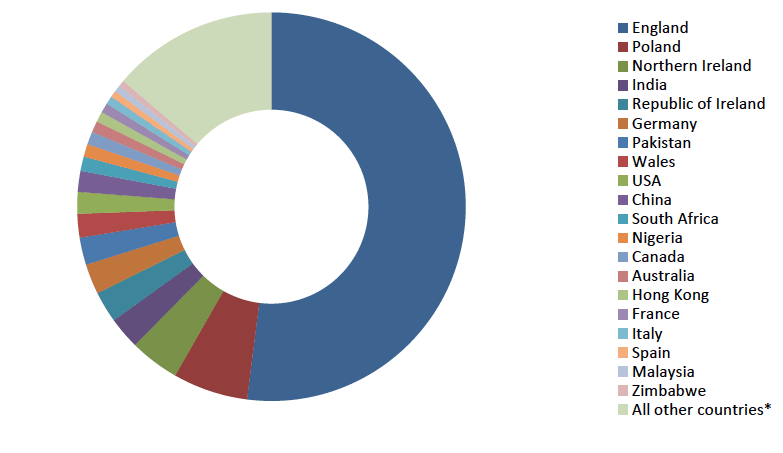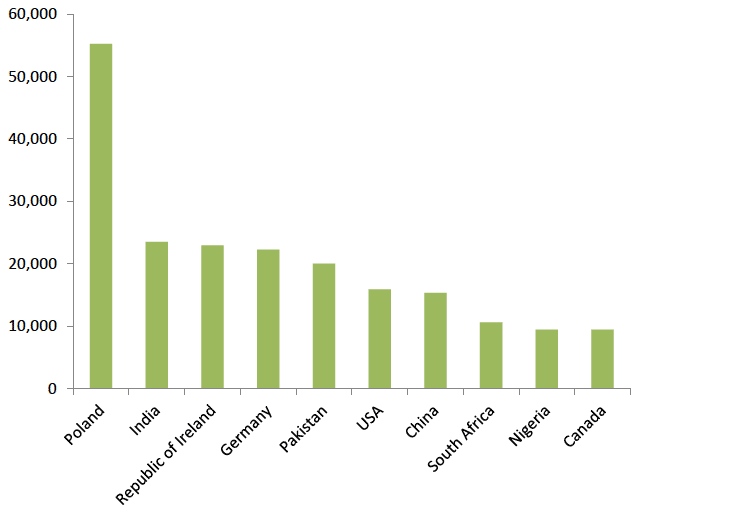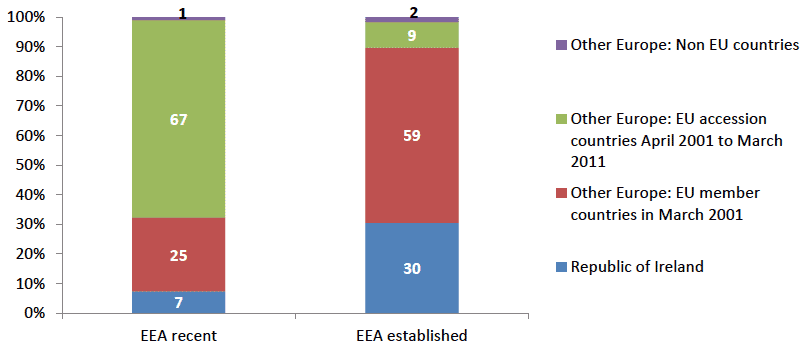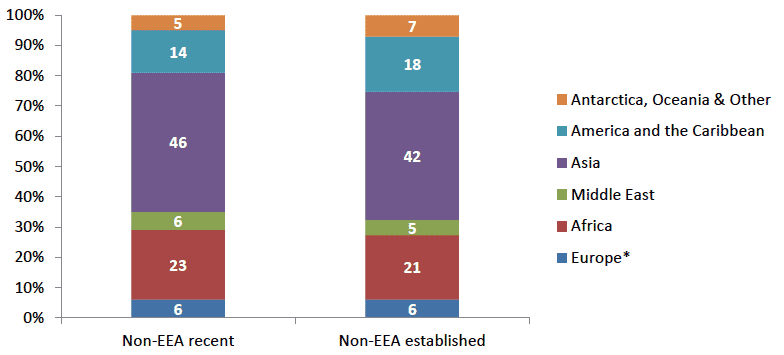Characteristics of migrants in Scotland: analysis of the 2011 census
Analysis of data from the 2011 census on the characteristics of migrants in Scotland. This is a revised version of a report published in March 2015.
1. Number and origin of migrants and length of residence
Number of recent and established EEA and non- EEA migrants in Scotland
At the time of the 2011 Census, over 369,000 people who had been born outside the UK were resident in Scotland: seven per cent of Scotland's total population.
The majority (63 per cent) of migrants had arrived in Scotland in the 10 years prior to
the 2011 Census. Around half of these recent migrants came from EEA countries.
See Table 1.1.
Of the 37 per cent of migrants who arrived in Scotland 10 years ago, or longer, nearly two thirds were born outside the EEA, and just over a third were born in an EEA country. The number of EEA migrants in Scotland more than doubled in the 10 years between 2001 and 2011 [2] .
The Census questionnaire only asked people born outside the UK to give the date of their most recent arrival in Scotland. Therefore the tables and charts in this section of the report do not include information about the recent and established migrant populations from other countries in the UK.
Table 1.1. Total number of non- UK migrants resident in Scotland, and relative proportion of migrant groups as a proportion of the population
| EEA | Non- EEA | Total | |
|---|---|---|---|
| Recent | 111,213 30% |
119,976 32% |
231,189 63% |
| Established | 48,710 13% |
89,385 24% |
138,095 37% |
| Total | 159,923 43% |
209,361 57% |
369,284 100% |
Source: Scotland's Census 2011 Census - NRS: Table AT_098_2011.
Countries of origin
Just over half of all migrants living in Scotland in 2011 (almost 460,000) were born in England, and almost 36,700 were born in Northern Ireland.
The top overseas country of birth for residents in Scotland was Poland (approximately 55,000 people). At the time of the 2001 Census, just 2,500 people from Poland were living in Scotland.
Chart 1.1 details the countries of origin of migrants to Scotland, including countries in the rest of the UK. The chart indicates the diversity of Scotland's migrant population: more than 4,000 people from each of the countries listed were living in Scotland).
Chart 1.1. Countries of origin: migrants in Scotland (2011)

* Includes the Netherlands, Latvia, Lithuania and the Philippines, among others.
Source: Scotland Census 2011 - NRS: Country of birth (detailed) all people
Chart 1.2 shows the size of migrant populations from each of the top ten countries of birth of non- UK migrants. After Poland, the most popular non- UK country was India: 23,500 migrants from India were living in Scotland (in 2001 the number was 10,500).
Chart 1.2. Top ten sources of non- UK migrants to Scotland, 2011

Source: Scotland Census 2011 - NRS: Country of birth (detailed) all people
Charts 1.3 and 1.4 provide a breakdown of EEA and non- EEA countries by recent and established migrant populations in Scotland.
Chart 1.3 shows the very different composition of the EEA recent and established migrant groups. Two thirds of recent EEA migrants came from the countries that acceded to the EU between April 2001 and March 2011 (particularly Poland, as noted above). More than half of all established EEA migrants came from countries that were members in March 2001, and almost one third were from the Republic of Ireland.
However, the breakdown of countries of origin for non- EEA migrant groups shows little difference between the recent and established groups (Chart 1.4).
Chart 1.3. Countries of origin - recent and established EEA migrants

Source: Scotland's Census 2011 - NRS: Table AT_098_2011
Chart 1.4. Countries of origin - recent and established non- EEA migrants

* Europe includes Channel Islands and Isle of Man, and non- EU countries
Source: Scotland's Census 2011 - NRS: Table AT_098_2011
Length of residence of recent migrants
Approximately a third of all recent migrants arrived in the two years prior to the 2011 Census, a third between 2 and 5 years before the Census, and a third between 5 and 10 years before the Census. See Chart 1.5.
A relatively large proportion (39 per cent) of the recent non- EEA migrant group arrived in the two years before the Census. This is likely to be due, at least in part, to the larger proportion of students in the recent non- EEA migrant group (see Section 4 on education and employment).
Chart 1.5. Length of residence in Scotland: all recent non- UK migrants

Source: Scotland's Census 2011 - NRS: Table CT_0143a_2011
Age at arrival
At least two-thirds of recent migrants arrived in the UK when they were aged between 16 and 34. Many established migrants, on the other hand, came to the UK when they were children: half of all established migrants in both EEA and non- EEA groups arrived when they were under 16 years of age. Just five per cent of EEA and seven per cent of non- EEA established migrants arrived when they were aged 35 or older. See Chart 1.6.
Chart 1.6. Age at arrival in the UK: EEA and non- EEA recent and established migrants

Source: 2011 Census, National Records of Scotland. Table AT_078_2011
Contact
There is a problem
Thanks for your feedback